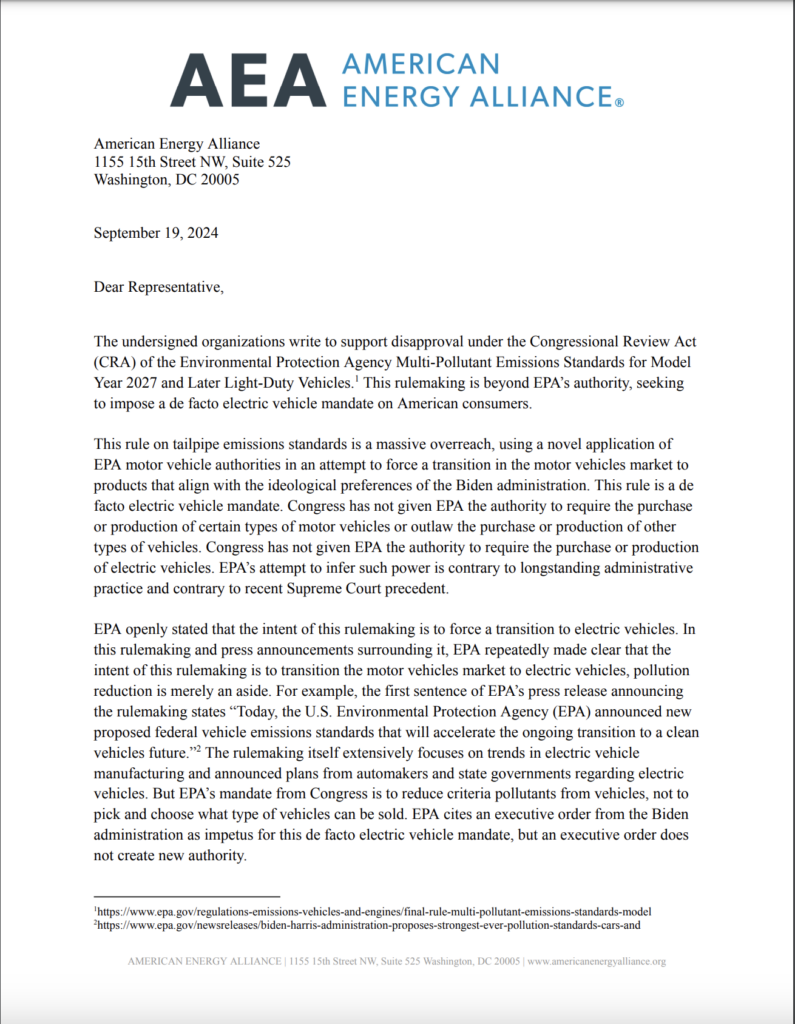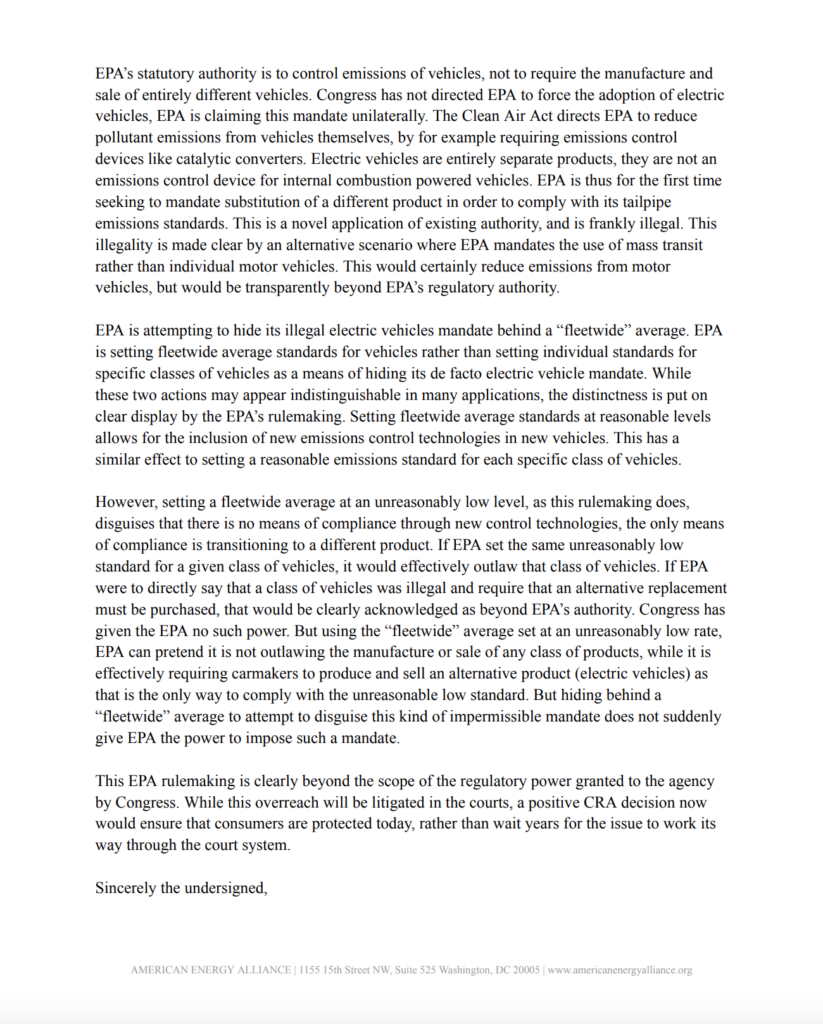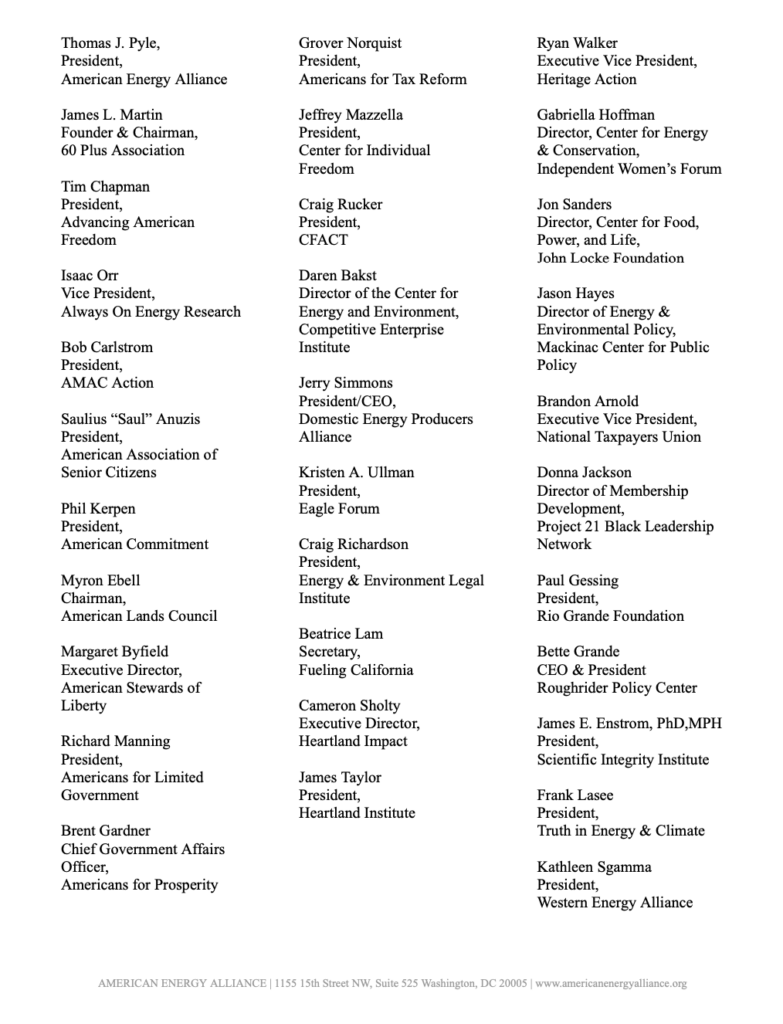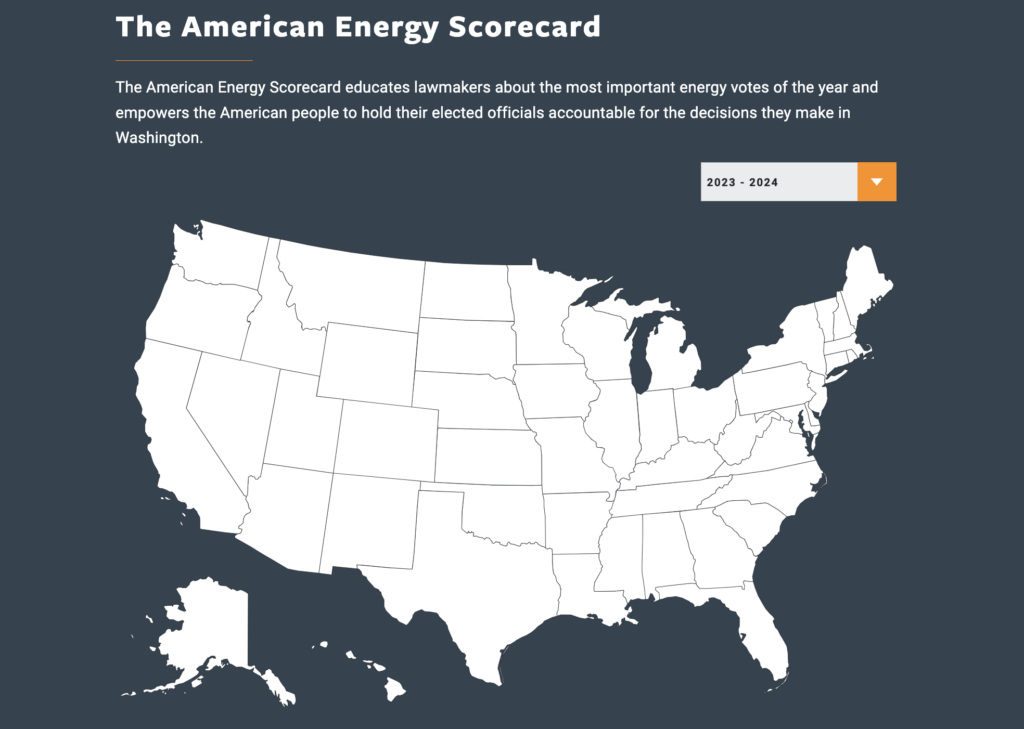On this episode of The Unregulated Podcast Tom Pyle and Mike McKenna are joined by friends of the show to celebrate their two-hundredth episode!
Links:
Stay Connected With The Show:
Thanks for joining the AEA efforts to help combat rising energy prices. We don’t want to bug you that often, so let us know what energy issues interest you, and we’ll keep your inbox happy.
On this episode of The Unregulated Podcast Tom Pyle and Mike McKenna are joined by friends of the show to celebrate their two-hundredth episode!
Links:
Stay Connected With The Show:
WASHINGTON DC (9/24/2024) – The American Energy Alliance (AEA), the country’s premier pro-consumer, pro-taxpayer, and free-market energy organization, is proud to endorse Senator Rick Scott (R-FL) for reelection to the U.S. Senate.
Senator Scott was one of only five Senators to receive AEA’s Energy Champion designation this year, with a full-term score of 96%.
The AEA Scorecard informs voters on how their elected representatives in Washington vote on policies that impact the availability, reliability, and cost of energy. It holds lawmakers accountable for their votes, not their rhetoric, when it comes to policies that affect families and businesses.
Thomas Pyle, President of the American Energy Alliance, issued the following statement:
“Senator Scott’s commitment to promoting American energy and protecting consumers from rising costs makes him the clear choice for Floridians and the nation.
“His consistent support for expanding domestic energy production has been critical to strengthening our nation’s energy security, protecting American jobs, and ensuring that families and businesses are not burdened by rising fuel costs.
“His strong opposition to heavy-handed regulations that stifle energy innovation and support for an overhaul of the permitting process system shows that he understands the drivers behind a strong economy.
“In contrast, Senator Scott’s challenger, Debbie Mucarsel-Powell was a co-sponsor of the Green New Deal, a socialist wishlist of proposals which would undoubtedly send energy prices skyrocketing and cripple our economy. Floridians, and the country, deserve better.
“The American Energy Alliance proudly endorses Senator Rick Scott for United States Senate to ensure all Floridians continue down the path of prosperity.”
AEA Experts Available For Interview On This Topic:
Additional Background Resources From AEA:
The Biden administration’s attempt to set new emissions standards on electric vehicles was blocked by a bipartisan group of lawmakers on Friday.
The Environmental Protection Agency (EPA) announced a final rule in March under the Clean Air Act to set new emissions standards that would require up to two-thirds of new cars sold to be electric vehicles by 2032.
The new standards would affect “light-duty vehicle manufacturers, independent commercial importers, alternative fuel converters, and manufacturers and converters of medium-duty vehicles,” according to the EPA’s final rule.
[…]
The bill’s passing comes just one day after the American Energy Alliance and over two dozen energy groups sent a letter to members of Congress urging them to pass the CRA.
“This rule on tailpipe emissions standards is a massive overreach, using a novel application of EPA motor vehicle authorities in an attempt to force a transition in the motor vehicles market to products that align with the ideological preferences of the Biden administration,” the groups wrote in a letter to lawmakers on Thursday.
WASHINGTON DC (9/20/24)– American Energy Alliance President, and founding member of the Save Our Cars Coalition, Thomas Pyle issued the following statement today following House passage of the resolution of disapproval on the Environmental Protection Agency’s (EPA) tailpipe emissions rule (H.J. Res. 136):
“In the State of the Union earlier this year, President Biden declared that freedom was under attack in the United States. He should know because his Administration is the reason. He and Vice President Harris have tried to bypass Congress by using bureaucrats to push their ideological EV agenda while attempting to sell a different story to the public. Today the House told them no.
“Since becoming her party’s nominee, Vice President Harris has tried to walk back her long standing support of EV mandates. If she truly wants to show the American people that she has changed her stance, and that she cares about their freedoms, now is the time for her to call on her former colleagues in the Senate to vote on this resolution.
“Americans deserve the freedom of choice to make their own informed decisions about their transportation options. I commend the House on their passage of this resolution today and look forward to seeing it on the Senate calendar soon.”
Yesterday, a diverse coalition, led by the American Energy Alliance (AEA) and several members of the Save Our Cars Coalition, sent a letter to all members of the House of Representatives in support of H.J.Res 136. The 31-member coalition includes prominent national and state-based free-market organizations, trade associations, consumer and taxpayer protection groups, and grassroots organizations.
AEA Experts Available For Interview On This Topic:
Additional Background Resources from AEA:
This week Tom and Mike are both on the road. Last week, Mike sat down with Jim Burling, of Pacific Legal Foundation, to discuss the housing crisis and his new book Nowwhere to Live.
Our listeners are welcome to join us on Wednesday September 25th from 4 – 7pm in the Washington D.C. American Energy Alliance offices for the recording of the 200th episode and a happy hour.
To RSVP to the 200th episode, please email: [email protected]
Links:
Stay Connected With The Show:
WASHINGTON DC (9/19/2024) – A diverse coalition, led by the American Energy Alliance (AEA) and several members of the Save Our Cars Coalition, sent a letter today to all members of the House of Representatives in support of the resolution of disapproval on the Environmental Protection Agency’s (EPA) tailpipe emissions rule. The 32* member coalition includes prominent national and state-based free-market organizations, trade associations, consumer and taxpayer protection groups, and grassroots organizations.
The EPA’s tailpipe emissions rule would set emissions requirements so high that auto companies would be eventually forced to manufacture all-electric vehicles (EVs) in order to meet the targets, thus implementing an EV mandate. A vote on this resolution is expected today.
Thomas Pyle, president of the American Energy Alliance, issued the following statement:
“In a move that shocks no one, the Biden-Harris EPA has once again overstepped its authority with their EV mandate. By prioritizing politics over personal freedoms, this Administration is destroying the cornerstone of our economy – consumer choice.
“The Democrats claim to stand with the American working class, yet they are leaving no stone unturned in their quest to make driving and mobility unaffordable for them.
“What the Biden-Harris Administration is trying to do with his mandate is deceptive, ill-advised, and a gross overreach of power. While it will undoubtedly be litigated by those who stand on the side of consumer choice and economic freedom, passage of the CRA resolution will ensure consumers are protected today.
“The Vice President claims she no longer supports an EV mandate. She should prove it by sending word to Capitol Hill that her boss should sign the CRA if it comes to his desk.”
To read the full letter click here.



*At the time of first publication, the total number of signatory organizations was 28. Four additional organizations (60 Plus Association, American Association of Senior Citizens, Independent Women’s Forum, and the Roughrider Policy Center) joined shortly thereafter and are included in the text of the letter available for download here.
AEA Experts Available For Interview On This Topic:
Additional Background Resources from AEA:
Under the Biden-Harris administration, the United States, a leading global producer of plastics, will now back a global treaty aimed at curbing the annual production of new plastics, which is expected to decrease U.S. manufacturing output. Initially, the U.S. favored a framework where individual nations would devise their own strategies, akin to the Paris Agreement, rather than imposing production limits, which was the European negotiators’ preference. This shift from a more decentralized approach to a global production cap places the U.S. in direct opposition to countries like Saudi Arabia and China. Those countries have argued that the UN treaty, which negotiators are scheduled to conclude at a November summit in Busan, South Korea, should ignore questions of production and focus on downstream measures, such as encouraging recycling and changing packaging design.
This policy adjustment aligns the United States more closely with a coalition of “so-called high ambition countries” that includes not only EU member states but also South Korea, Canada, Rwanda, and Peru. The group has also targeted a list of chemicals used in plastic production that they say should be eliminated. The United States now supports creating a global list of chemicals and setting global criteria to identify those chemicals that should be considered “avoidable plastic products” to phase out.
The debate over whether a UN treaty should include production limits has been heated, with major plastic and petrochemical producers like Saudi Arabia and China obstructing discussions on production caps. They argue that the focus should remain on less controversial issues, such as managing plastic waste. Over the past 15 years, China has significantly driven global plastic demand. Despite some bans on single-use products starting in 2019, China accounted for half of the 15 million metric tons of new production capacity added between 2019 and 2021. Sinopec, a major Chinese company, is expected to build new facilities through 2027, adding over 5 million metric tons of annual capacity. Although China’s production growth is predicted to slow, the country still leads half of the top 20 companies planning to expand their virgin polymer capacity by 2027. Meanwhile, Saudi Arabia is backing its state-owned oil company, Saudi Aramco, which plans to channel nearly one-third of its oil output to petrochemical production for plastics by 2030.
The American Chemistry Council (ACC) believes the Biden-Harris administration “caved” to the interests of environmental groups’ demands. Although the ACC supports a global treaty on plastics, it opposes any measures involving production caps or chemical restrictions. Chris Jahn, the ACC president, stated, “The administration’s new stance on supporting plastic production limits and regulating chemicals through the UN Plastics Agreement indicates a willingness to compromise U.S. manufacturing interests and the numerous jobs it sustains.” The petrochemical sector contends that production caps would lead to increased consumer prices. They advocate for a treaty focused on managing plastics after production, emphasizing the importance of promoting reuse and recycling technologies, such as converting plastic into fuel. Their focus is on encouraging the reuse or recycling of plastics, including deploying technology that can turn plastic into fuel and they argue that companies should be allowed to disclose the chemicals used in production voluntarily.
These policy changes by the Biden-Harris administration come ahead of an upcoming meeting in Bangkok, which will coincide with ongoing treaty negotiations later this month. They follow the recent announcement of new U.S. policies aimed at combating plastic pollution. The White House revealed plans to phase out the use of single-use plastics from all federal operations by 2035, with a target to stop federal procurement of such plastics for food services, events, and packaging by 2027. This policy will affect a wide range of federal facilities, from park concession stands to military feeding operations. The new goal would supposedly be met by selecting reusable, compostable, and highly recyclable products in lieu of single-use plastics in food service. The move comes after the Biden-Harris administration’s 2022 decision to phase out single-use plastics in national parks and public land. The Biden-Harris administration also unveiled a new strategy, detailed in an 83-page document, targeting plastic pollution at the stages of production, processing, use, and disposal.
According to the White House, the new procurement policies are the latest effort aimed at addressing plastic pollution that has included several policies to tackle fossil-fuel intensive polymer production, recycling and removing plastic that has washed up in oceans. The Biden-Harris Environmental Protection Agency has issued rules to limit emissions from the production of chemicals used to make plastic, and plans to spend $275 million to improve recycling infrastructure. Secretary of the Interior Deb Haaland has also issued Secretary’s Order 3407 to reduce single-use plastic products and packaging within the Department of the Interior, aiming for a phase-out by 2032. To promote this effort, the interior department is installing more water bottle filling stations on public lands and working with concessionaires to reduce single-use plastics. Vice President Kamala Harris has called for the banning of plastic straws.
Limiting plastics production and use is consistent with the Biden-Harris Administration’s opposition to oil and gas, from which plastics are made. The Administration has taken over 225 actions designed to make it more difficult or impossible to create more oil and gas. Since plastics are a building block of modern economies, focusing on plastic waste which is visible but for which the United States and other advanced countries are not primarily responsible would assist the Biden-Harris Administration in its stated goal to “end fossil fuels.”
Conclusion
Plastics are versatile and are used in many industries from health to food storage. Limiting their production in order to deal with single-use plastic waste pollution is like attacking a nail with a sledge hammer. But politics in the EU and the United States is moving in that direction daily with regulations and edicts on what Americans are allowed to buy, what fuels can run their vehicles, what fuels can produce electricity, what fuels can heat their homes and what fuels they are allowed to cook with. Under the Biden-Harris administration’s mandates, the market will no longer be able to determine what technology and sources are best for Americans.
In 2019, then-U.S. Senator, Kamala Harris participated in a CNN townhall focused on climate change. When asked if the federal government should ban single-use plastics, this was her answer.
*This article was adapted from content originally published by the Institute for Energy Research.
WASHINGTON DC (9/17/24) – The American Energy Alliance (AEA), the country’s premier pro-consumer, pro-taxpayer, and free-market energy organization, is proud to endorse Senator Ted Cruz (R-TX) for reelection to the U.S. Senate.
Senator Cruz was one of only five Senators to receive AEA’s Energy Champion designation this year, with a full-term score of 96%.
The AEA Scorecard informs voters on how their elected representatives in Washington vote on policies that impact the availability, reliability, and cost of energy. It holds lawmakers accountable for their votes, not their rhetoric, when it comes to policies that affect families and businesses.
Thomas Pyle, president of the American Energy Alliance, issued the following statement:
“Senator Cruz has consistently proven himself to be a steadfast champion of American energy independence, standing firm against policies that harm our energy sector and drive up costs for Texas families and businesses alike. This includes his introduction of legislation to repeal the Biden-Harris Administration’s natural gas tax, which would particularly harm Texas by undermining producers in the Permian Basin and across the state.
“Throughout his tenure in the Senate, Senator Cruz has cast critical votes to protect and support American workers and promote energy security. His unwavering commitment to free-market principles and opposition to burdensome and often duplicative regulations has made him a champion for his constituents, including the men and women working in the Texas energy industry that powers our economy.
“On the other hand, Sen. Cruz’s opponent, Representative Colin Allred has been a disappointment on energy policy. He repeatedly tries to assure Texans that he supports the industry that generates over a million jobs in his home state, while simultaneously supporting the Big Green, Inc. agenda. Representative Allred has consistently voted against legislation to strengthen America’s energy economy. He is the wrong choice for Texas.
“The American Energy Alliance proudly endorses Senator Ted Cruz for reelection. We believe Texans need him back in the Senate to continue fighting for families and businesses across the state and stop the needless attacks on the American energy industry.”
AEA Experts Available For Interview On This Topic:
Additional Background Resources From AEA:
On this episode of The Unregulated Podcast Tom Pyle and Mike McKenna discuss Vice-President Harris’ new found love of fracking, the upcoming budget battle on Capitol Hill, and the latest pot-holes on the road to an “all-EV” future.
Links:
Stay Connected With The Show:
This week, the American Energy Alliance released its 2024 American Energy Scorecard for the United States Senate. The AEA scorecard scores voting and co-sponsorship decisions on legislation affecting energy policy in order to educate voters on how their representatives vote and hold members accountable for their voting records. This year’s scorecard compiles 27 votes from the Senators who will be finishing their latest term in the 118th Congress. Unfortunately, only 5 Senators achieved a 90% score, the minimum score AEA’s scorecard uses to classify a Senator as an Energy Champion. Only one Senator achieved a 100% score, in contrast to the 90 representatives in the House who did.
The following core principles guide the American Energy Scorecard:
All members are provided advanced notice that AEA plans to score an upcoming vote. The scored votes over the six year terms served by the Senators cover a range of energy and environmental policy issues.
The full list of Senatorial American Champions completing their six year term in the 118th Congress (Senatorial Class 1):
The following members of Senatorial Class 1 are close runners up to our champions and should also be commended for their commitment to securing our energy future:
While AEA applauds all the five members who achieved 90%, and the runner-ups, we must also note those members in key races whose voting record was harmful to their districts. Of the many low-scoring Senators, Senators John Tester (16%) of Montana, Martin Heinrich (7%) of New Mexico, Sherrod Brown (4%) of Ohio, and Bob Casey (11%) of Pennsylvania, were especially noticeable given the important role energy production plays within their states’ economies.
Additionally, below is a list of the Senators who scored a 0% over the course of their latest term:
To view the 2024 Energy Champions for the House of Representatives visit this page.To see the full results please visit the American Energy Scorecard.
